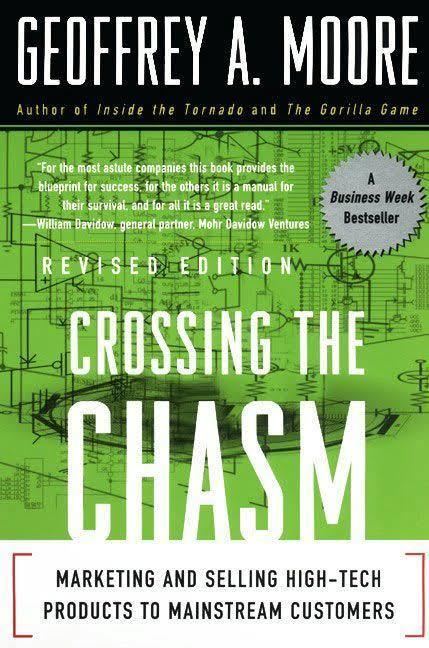8 /10 1 Votes8
Language English Published in English 1991 Pages 227 Page count 227 Country United States of America | 4/5 Goodreads Publication date 1991 Media type Book Originally published 1991 Publisher HarperCollins Genre Non-fiction | |||||||||||||||||||||||||||||||||
 | ||||||||||||||||||||||||||||||||||
Subject Marketing high-tech products Similar Geoffrey Moore books, Non-fiction books, Management books | ||||||||||||||||||||||||||||||||||
Crossing the chasm by geoffrey moore tel 156
Crossing the Chasm: Marketing and Selling High-Tech Products to Mainstream Customers or simply Crossing the Chasm (1991, revised 1999 and 2014), is a marketing book by Geoffrey A. Moore that focuses on the specifics of marketing high tech products during the early start up period. Moore's exploration and expansion of the diffusions of innovations model has had a significant and lasting impact on high tech entrepreneurship. In 2006, Tom Byers, director of the Stanford Technology Ventures Program, described it as "still the bible for entrepreneurial marketing 15 years later". The book's success has led to a series of follow-up books and a consulting company, The Chasm Group.
Contents
- Crossing the chasm by geoffrey moore tel 156
- High tech b2b marketing crossing the chasm market domination
- Synopsis
- Pre chasm
- Sales figures
- References
High tech b2b marketing crossing the chasm market domination
Synopsis
In Crossing the Chasm, Moore begins with the diffusion of innovations theory from Everett Rogers, and argues there is a chasm between the early adopters of the product (the technology enthusiasts and visionaries) and the early majority (the pragmatists). Moore believes visionaries and pragmatists have very different expectations, and he attempts to explore those differences and suggest techniques to successfully cross the "chasm," including choosing a target market, understanding the whole product concept, positioning the product, building a marketing strategy, choosing the most appropriate distribution channel and pricing.
Crossing the Chasm is closely related to the technology adoption lifecycle where five main segments are recognized: innovators, early adopters, early majority, late majority and laggards. According to Moore, the marketer should focus on one group of customers at a time, using each group as a base for marketing to the next group. The most difficult step is making the transition between visionaries (early adopters) and pragmatists (early majority). This is the chasm that he refers to. If a successful firm can create a bandwagon effect in which enough momentum builds, then the product becomes a de facto standard. However, Moore's theories are only applicable for disruptive or discontinuous innovations. Adoption of continuous innovations (that do not force a significant change of behavior by the customer) are still best described by the original technology adoption lifecycle.
Pre-chasm
Pre-chasm, in technology entrepreneurship, describes the phase prior to Crossing the Chasm that focuses on the specifics of marketing high-tech products during the early start- up period. Pre-chasm was suggested as an extension to Moore's model, arguing that the phase prior to the "chasm" is left unintended and that it, driven by technology commoditization and lean startup principles, requires an ambidextrous approach to product development alongside marketing to achieve product-market fit.
Sales figures
Moore and his publisher originally thought that the book would sell around 5,000 copies. By 2002, ten years after the first publication, more than 300,000 copies had been sold. Moore attributes this to word-of-mouth marketing, resonating initially with high-tech managers, then to engineers, venture capitalists and finally business schools. The book's success led to a number of sequels including Inside the Tornado, Living on the Fault Line and The Chasm Companion. Crossing the Chasm is available in several prints, one is ISBN 0-06-051712-3.
